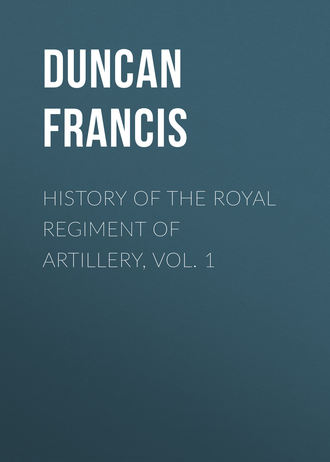 полная версия
полная версияHistory of the Royal Regiment of Artillery, Vol. 1
"In the English Service.
1692. "I marched with the English Artillery to the Battle of Steenkirke, and after the battle was ordered with a Detachment of Fireworkers to joyn at Ostend those Artillery people which came from England under the command of Sir Martin Beckman. From Ostend we marched to Tourney, from thence to Dixmud, and at last to quarter at Ghent.
1693. "I was commanded with a Detachment of Fireworkers and Bombardiers to Liege, and from thence back again to Nearhespe, where we fought the battle of Landen, and where our Army was beat, and sixty-three pieces of English cannon lost. After the battle I was ordered with a detachment of Fireworkers to Sasvangand, in order to embark the great Artillery for a secret expedition; after some days' labour was ordered back again to the Army encamped at Nuioven, from thence into Flanders.
1694. "I went with my Lieutenant-Colonel Browne to the Siege of Huy, which place we took from the French in the month of September, by capitulation.
1695. "I was ordered with some mortars to follow the Duke of Wirtemberg, who commanded a detachment of the Army at Fort Knock invested by the said Duke. From thence I was ordered with a detachment of the Artillery to the Siege of Namur, which place I bombarded with twelve great mortars, and did throw about 4000 bombs (into the town, Cohorn's Work, and Terra Nova), before the siege was over. The town capitulated in August, and Cohorn's Work and Terra Nova in September.
1696. "Nothing material was done this year but making intrenchments, marching, and counter-marching with the Army.
1697. "This year was like the former till we encamped at Brussels, where the cessation of arms was proclaimed… In the month of September the Army marched into quarters, where the greatest part of the Artillery people were ordered to England, foreigners excepted, who were all discharged except myself and one by name Schlunt. I was ordered to embark all the English Artillery remaining in Flanders to be sent to England. I myself went with the last embarkation in the month of February."
1698 to 1701. "I remained in England without being in any action.
1702. "I was made Major to the Artillery in the bomb vessels sent on the expedition to Cadiz, under the command of His Grace the Duke of Ormond and Admiral Rooke. In this expedition I bombarded with five bomb vessels, first, St. Catharina, with such success that it capitulated. I also bombarded with some land mortars the Fort Matagorde. At our arrival at Vigo, I bombarded with three bomb vessels Fort Durand, which was taken sword in hand by the land forces. The Fleet entered and broke the boom which was laid over the entrance of the harbour near the said Fort, took and destroyed all the ships of war, galleons, &c., to the number of thirty-seven.
1703. "Went as voluntier to Flanders. After some months' stay was recalled to England in order to command the English Artillery ordered to Portugall, with this present Emperour, being at that time King of Spain. Two of the transports laden with stores under my command were lost in the great storm in the Downs, where myself then rode, and was afterwards obliged to go to Portsmouth to repair the damage we had received by that storm.
1704. "Nothing material done with the Army but marching and counter-marching.
1705. "I was at the Siege of Valencia d'Alcantra, which the English took from the Spaniards sword in hand. At this siege, in building the Battery, I had my left arm shot to pieces.
1706. "I was at the Siege of Alcantra, which place the English and Allies took by capitulation in the month of April. Here I received a contused wound on my left breast. Marched from thence to Corea and Plazencia. Both towns declared for King Charles, and from thence marched to the Bridge of Almaraz, and so back to Corea and to Ciudad Rodrigo, which place we besieged and took by capitulation in the month of May. Marched from thence to the Town Salamanca, which place declared for King Charles: from thence to Madrid, which likewise declared for King Charles, where we encamped ten days. From Madrid we marched to Guadalaxara; from thence to Guadraka, where I cannonaded in the month of August for two days together the Duke of Berwick's Army; from thence marched back to Guadalaxara, and so on to St. Jonne, from which place we retreated into the kingdom of Valencia, where the enemy followed us close till we had got over the pass at Raguina.
1707. "In the month of April we marched from Valencia to the Battle of Almanza, where our Army was totally routed, and the remaining part retreated to Toroza in Catalonia. In this battle we lost all the Portuguese Artillery, and most part of the Artillery people were taken prisoners or cut to pieces; and I had the misfortune to lose all my baggage.
1708. "I commanded the Artillery on the expedition with Major-General Stanhope to the Island of Minorca, where we landed in September, and after I had built my battery by which I dismounted the cannon of two of the enemy's towers built in the line, the Castle of St. Phillip capitulated in the latter end of October. The whole Island, at our landing, declared for King Charles, and after having been three months in regulating the Artillery, I returned back to Catalonia in the month of February, 1708-9.
1709. "Marched with the Artillery to Villa Nova de la Barkia, on the River Segra, where I bombarded for some days the enemy's Army, and after our Army had passed the river, they took the town Balaguar, after two days' siege, by capitulation.
1710. "In the month of July I was at the Battle of Almenar, where our Army in less than two hours beat the enemy and encamped in the place of the field of battle for some days…" "From the camp at Almenar we marched to besiege the Castle Moncon. We possessed ourselves the first night of one of the enemy's works that covered their bridge laid over the Cuica river, and continued there some days, and at last was obliged to leave the place…" "In August, marched from thence and passed the said river near Traga in pursuit of the enemy to the place of Saragoso, where we fought a battle on the 20th August, got a compleat victory, and took the greatest part of the enemy's Artillery. Here I received four wounds, and had upwards of eighty men killed and wounded on my battery, and above 300 Artillery mules hamstringed. From this place our Army pursued the enemy, and marched to Madrid, which declared a second time for King Charles. Two months after, I was carried thither, and from thence ordered to Toledo to put that Artillery, &c., we had taken from the enemy in order; and after some days' stay was ordered to destroy the said Artillery, and march to joyn part of the Army in camp at St. Jonne, from whence we marched in the month of December, and joyned the whole Army near Villa Viciosa, where we fought a battle the 10th December with the loss of all our Artillery, and were obliged to retreat into the Kingdom of Arragon. I was wounded with a cannon-shot in my left leg, lost all my baggage, and was taken prisoner in the town of Siguenca.
1711. "I obtained leave upon my parole to go to England, to be cured of my wound; and after my arrival had the good fortune to be exchanged for another Colonel belonging to the enemy.
1713. "I made pleasure fireworks which were burnt on River Thames in the month of August, over against Whitehall, on the Thanksgiving Day for the Peace made at Utrecht.
1715. "In the month of December I was ordered with a train of Artillery to Scotland, and arrived in the month of February in the Firth of Forth by Leith, where I was ordered by His Grace the Duke of Argyle to send the vessells with the Artillery to a place called Innerkithen till further orders, and to march with all the officers and Artillery people from Edinburgh to Stirling. At Stirling I was ordered by His Grace to take upon me the command of fifteen pieces of cannon ordered from Edinburgh, &c., for field service, which was in such confusion as cannot be expressed; part of which Artillery I brought so far as the town of Dundee, where I was ordered to bring the Train back again to Edinburgh by water.
1716. "In the month of March I was ordered by General Cadogan, in His Grace the Duke of Argyle's absence, to send the vessells with the Artillery back again to London, and the Train people to march from thence. On our arrivall at London, I was ordered by the Board of Ordnance to lay before them tables and draughts of all natures of brass and iron cannon, mortars, &c., which was done accordingly and approved of. After the said draughts, two 24-pounder brass cannon were ordered to be cast by Mr. Bagley in his Foundry at Windmill Hill, at the casting of which I was ordered to be present. In the founding, the metal of one of the gunns blow'd into the air, burnt many of the spectators, of which seventeen dy'd out of twenty-five persons, and myself received four wounds.
1717, 1718. "The Board came to a resolution to regulate what was wanting to compleat a compleat Artillery for sea and land service. I had an order to lay before them draughts of all natures of carriages, wheels, trucks, grapes, and matted shot, and all sorts of bombs both great and small for land and sea service, with a great many other things relating to an Artillery too tedious to mention, which they approved of. I likewise laid before the Board the ill-state of the Laboratory, which the Board order'd me to put in some better order, and to be at as little expence as possible, which I did accordingly.
1719. "I was ordered on the expedition to Vigo, which place I bombarded with forty-six great and small mortars of my own projection, which answered their intended end, of which my Lord Cobham, and the rest of the generall officers can give a better account than myself, by which bombardment the Castle of Vigo was obliged in the month of October to surrender.
1720 to 1722. "I attended the Service, as formerly, at all surveys, &c., relating to the Artillery till such time Colonel Armstrong was made Surveyor, after which time, notwithstanding His Majesty's signification to me for regulating the Artillery for sea and land service, I was never consulted in anything relating to the said service.
"His late Majesty was graciously pleased to renew my old commission as Colonel, and to give me the command of the Regiment of Artillery established for His service, consisting of four companys."9
DATE OF LIEUT. – GENERAL BORGARD'S COMMISSIONS, AND BY WHOM SIGNED.
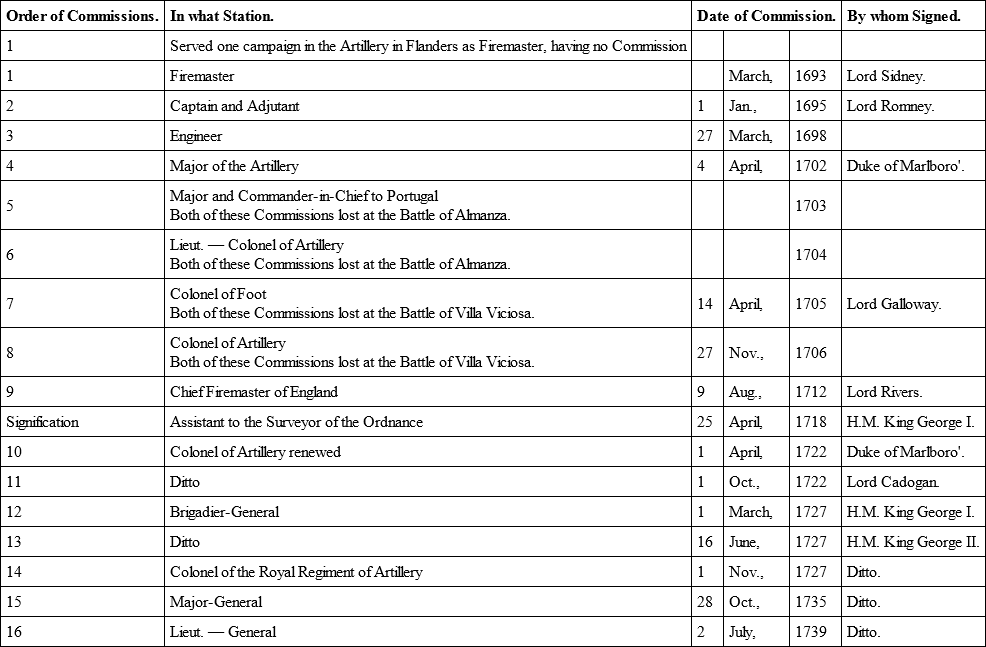
ABSTRACT OF ALL THE SIEGES
Lieut. – General Borgard has been present at from the year 1675.
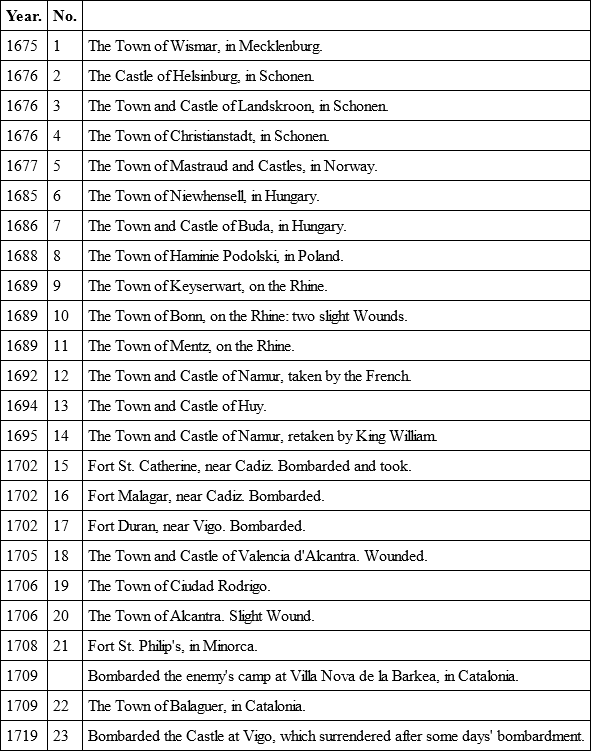
ABSTRACT OF THE BATTLES
Lieut. – General Borgard has been present at from the year 1675.
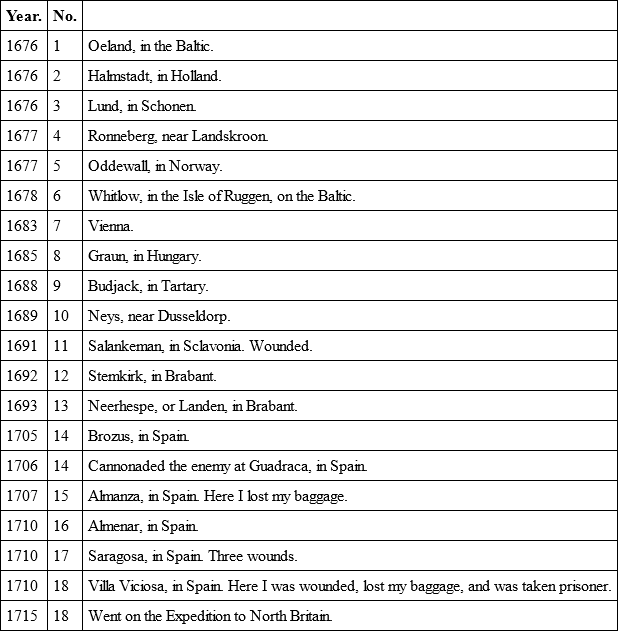
CHAPTER IX.
Twenty Years. 1722-1741
Twenty years, during which Englishmen made no conquests; but during which they had "peace, ease, and freedom; the Three per Cents, nearly at par; and wheat at five- and six-and-twenty shillings a quarter."10
Twenty years, during which England's army did not exceed 26,000 men; when there was actually a war of succession in Europe, and our rulers did not interfere; during which our King could go to Hanover for a couple of years, and the coach of the State move on steadily and without interruption in his absence; and during which our only alarms of war were two in number, and speedily disappeared.
It was a favourable childhood for the Regiment; it gave time for the old establishments to dwindle away, and the new one to acquire consistency and strength with the funds which thus became available at the Ordnance; instruction to officers and men could be deliberately and systematically given; discipline could be learnt; the fortifications could be armed; and the defects of the original scheme of organization in the Regiment could be ascertained and quietly remedied, instead of being more rudely exposed in time of war.
Only three events occurred between 1722 and 1741, which are worthy of comment; but there are details connected with the every-day life of the Royal Artillery during that period, which, though unworthy of being called events, yet cannot but be interesting to the student.
The first was the camp at Hyde Park, in 1723, which was attended by a train of Artillery.
The second was in 1727, when the Spaniards laid siege to Gibraltar; a siege, however, which only lasted four months.
The third was in the same year, when the States-General of Holland, becoming nervous lest an attempt should be made on the Netherlands, called upon England to hold in readiness the contingent of 10,000, which she was bound by treaty to furnish, if required. For this, a train of Artillery was ordered to be prepared, and although not required, pacific counsels having prevailed in Europe, its constitution is worthy of mention.
In the camp at Hyde Park, held the year after the Regiment obtained its Colonel, probably for the amusement of the Londoners, there was a train of Artillery of twenty pieces of Ordnance, comprising two 6-pounders, four 3-pounders, and fourteen 1½-pounders. This battery was horsed by seventy-six horses, but the detail to the various natures of Ordnance cannot be traced. The officers and men attached to the battery were as follows: 1 captain, 1 lieutenant, 1 fireworker, 2 sergeants, 4 corporals and bombardiers, 20 gunners, 40 matrosses, and two drummers.
The Infantry was called upon to furnish a guard over the guns when parked, of twenty-five men. Six regiments of Dragoons, and twelve of Infantry of the Line, attended the camp.
In 1727, the bad feeling, which had for some time existed between England and Spain, produced an open rupture. A force of 20,000 Spaniards besieged Gibraltar, opening their trenches on the 11th of February. By means of reinforcements from England and Minorca, the garrison was increased to 6000 men, and the bomb-vessels, which were sent from England and from other parts of the Mediterranean, rendered great assistance by enfilading the enemy's entrenchments. The siege was raised on the 23rd June, having only lasted four months, during which time the Spanish loss had been great, while that of the English had been inconsiderable. With the reinforcements from England had come some guns and stores, which assisted to make the fort more easily defended, its previous armament having been but indifferent. Colonel Jonas Watson commanded the Royal Artillery during the siege, having arrived for that purpose from England, accompanied by Captain Hughes and some young officers. The force under his command was two hundred in number. The only Artillery officer killed during the siege was Captain-Lieutenant Holman.
In this the first defensive operation in which the Royal Regiment of Artillery was engaged – as in its first offensive at Vigo – it was on the successful side. And in both cases, it not merely represented, but it was the principal arm of the English forces. The next event, the third proposed to be chronicled, took place in the same year. The train which it was deemed probable would have to proceed to Flanders was for field, not garrison service. It comprised four 6-pounders, twelve 3-pounders, and eight 1½-pounders. There were also six Royal mortars to be provided. A complete company of Artillery – with the exception of the cadets of the company, and nine of its bombardiers – attended the train, and 12 artificers and 22 pontoon-men, under a bridgemaster, were also ordered to accompany it. Conductors and commissaries were also included. Unless, however, it was proposed to enlist foreign Artillerymen into the British service, on landing in the Continent, – the staff of the train seems certainly excessive.
For a total of 140 of all ranks – smaller than a single battery now – the following staff was detailed: 1 colonel, 1 comptroller, 1 paymaster, 1 adjutant, 1 chaplain, 1 quartermaster, 1 commissary of stores, 1 waggon master, 1 surgeon, 1 assistant-surgeon, 1 assistant provost-marshal, 1 kettledrummer and his coachman.
These, then, were the three military events of most note during the twenty years ending in 1741; and they are certainly not such as to affect the peaceable reputation of the period. An unhappy expedition to the West Indies, under Lord Cathcart, was ordered in 1741, but as it was not completed until later, it can be alluded to more fully in a succeeding chapter.
But the domestic life of the Regiment during this time requires description. The rank of Captain-Lieutenant had been introduced in 1720, and the third and fourth Lieutenant of a company were called Lieutenants and Fireworkers, the conjunction being speedily dropped. The strength of a company was during this period as follows: —
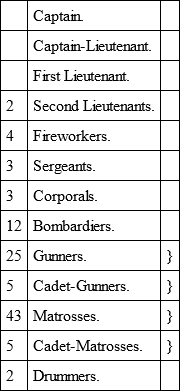
The annual pay of each company amounted to 2956l. 10s.
It was in 1727, that the Regiment was increased to four complete companies. The siege of Gibraltar suggested an augmentation which the declining numbers on the old establishment admitted of the Board carrying out. On this taking place, the staff requisite for the Regiment was added, and Colonel Borgard was styled Colonel-Commandant.
The staff consisted, in addition to the Colonel, of a Lieutenant-Colonel – Jonas Watson; a Major – William Bousfield; an Adjutant, a Quartermaster, and a Bridge-Master. To meet the demand for the more scientific element in the new companies, one Second Lieutenant and one Fireworker per company were transferred from the old, and the number of bombardiers and gunners in each reduced to eight and twenty respectively. The matrosses, as being more easily obtained, and requiring less special training, were increased to sixty-four per company; and from this time vacancies among the gunners were filled by the most deserving matrosses.
The large number of junior officers and of bombardiers in each company was intended to meet the demands of the bomb-service, which even in this peaceable time were very heavy: more especially for the bomb-vessels in the Mediterranean. It created, however, an evil which must always be found in a profession where the junior ranks so greatly outnumber the senior, and where the prizes are so few, while the candidates are many; – the evil of slow promotion and even stagnation, and in their wake, discontent, loss of zeal, and, at last, indifference. So soon did this manifest itself, that by reducing the number of junior officers, and increasing that of the seniors, it has been repeatedly attempted to remedy it; the last attempt being so recent as during the tenancy of the present Secretary of State for War – Mr. Cardwell. But this remedy has its limits. There are duties to be performed suitable only to inferior military rank, and the performance of which, by senior officers, would have the effect of degrading the rank to which they may have attained. A considerable proportion of an army's officers, therefore, must always hold inferior military rank; but whether the evil which accompanies stagnation in their ranks is to be remedied by increase of pay in proportion to service, or by enforced retirement in the upper ranks, is one of those questions which it is not for the historian to argue.
The Captains of the four companies of the Regiment after the augmentation were
Captain James Richards,
Captain Thomas Hughes,
Captain James Deal,
and Captain Thomas Pattison.
The first-mentioned two were at Woolwich with their companies, although compelled to furnish detachments for Scotland and the bombs; the third was at Gibraltar, and the fourth in Minorca. Special establishments still existed for Annapolis and Placentia. The pay per diem of an Artillery Captain was 10s.
It was in Minorca that the question of the military precedence of Artillery officers was first authoritatively settled. The officers of the four Infantry Regiments stationed there having refused to sit on courts-martial on the same terms as the officers of the train, the matter was referred to England, and by order of the King the Secretary at War informed the commandant at Port Mahon that whenever any of the Artillery were being tried, the officers of the train were to sit and vote with other officers of the Army, according to the dates of their commissions.
The objection taken by the Infantry officers was doubtless based on the fact that until 1751 the commissions of Artillery officers under the rank of field officer were signed by the Master-General, not by the King. This decision, however, settled the point effectually; and ten years later there is a record of the trial by court-martial in London of a deserter from the Artillery in which all the members of the Court were officers of the Guards, and the president belonged to the Artillery.
Among the places which were supplied with additional armament during this time of rest were Berwick, Plymouth, Portsmouth, and Hull, but the charge of the Ordnance and Stores still remained in the hands of the master-gunners and gunners of Garrisons, numbering at this time respectively 41 and 178. The value of these officials may be estimated by a description of certain accepted candidates for the appointment in 1725, who were "superannuated and disabled gunners, who have served long and well, and being too feeble for active service, are subsisted until they can be placed in the garrisons."
An augmentation to the companies was commenced in 1739, but not completed until the following year, when one new company was raised; the strength of the companies at home being increased to 150, and of those at Minorca and Gibraltar to 100. It was 1741 before the distribution of the companies at home was finally arranged; for it was found necessary to divide the three into four, for purposes of relief and detachment. At this time, – the end of the twenty years, the strength of the Regiment at home, in addition to the companies abroad, amounted to thirty-five officers, eighty non-commissioned officers, of whom fifty-six were bombardiers, twenty miners, ninety-two gunners, thirty-two pontoon-men, 184 matrosses, and eight drummers.
There were also sixteen cadet-gunners, and sixteen cadet-matrosses, the number in each of the four home companies having been reduced to four. It was from the cadets that the lieutenant-fireworkers were generally, although not always, chosen. The employment of officers of that rank on board the bomb-vessels without superior officers above them rendered it necessary often to promote non-commissioned officers, whose experience would enable them to carry on such an independent service, better than the young and inexperienced fireworkers, just promoted from among the cadets. The discipline among these young gentlemen may be gathered from the marginal remarks of the commanding officer on the muster-rolls of the two companies at Woolwich in 1739. After alluding to one officer as having been lame for six months, and to another as having lost his memory, and done no duty for seven years, he comes to the cadets of the companies. Out of the whole number of sixteen, there is a remark against the names of no less than nine, "I know not where they are," and against another, "A very idle fellow!" The remaining six were detached, two at Portsmouth, one in the Tower, one on board the bombs, and only two at Woolwich.
There is in the same list a remark made against the name of one, Captain-Lieutenant George Minnies, which might justly have been made against others of the same rank in later days, if indeed it may not also have to be made again, "old and worn-out in the service."
The end of this period brings us near to that time when the Regiment, having quitted the nursery, so to speak, entered the school of war, which was provided for it in Flanders. Before, however, tracing its story then, it will be well to describe some little matters connected with the foundation and early history of an institution which was founded in 1741, the last of our twenty years, to meet a want, which the above comments of the commanding officer must prove most distinctly to have existed.
CHAPTER X.
Foundation of the Royal Military Academy

